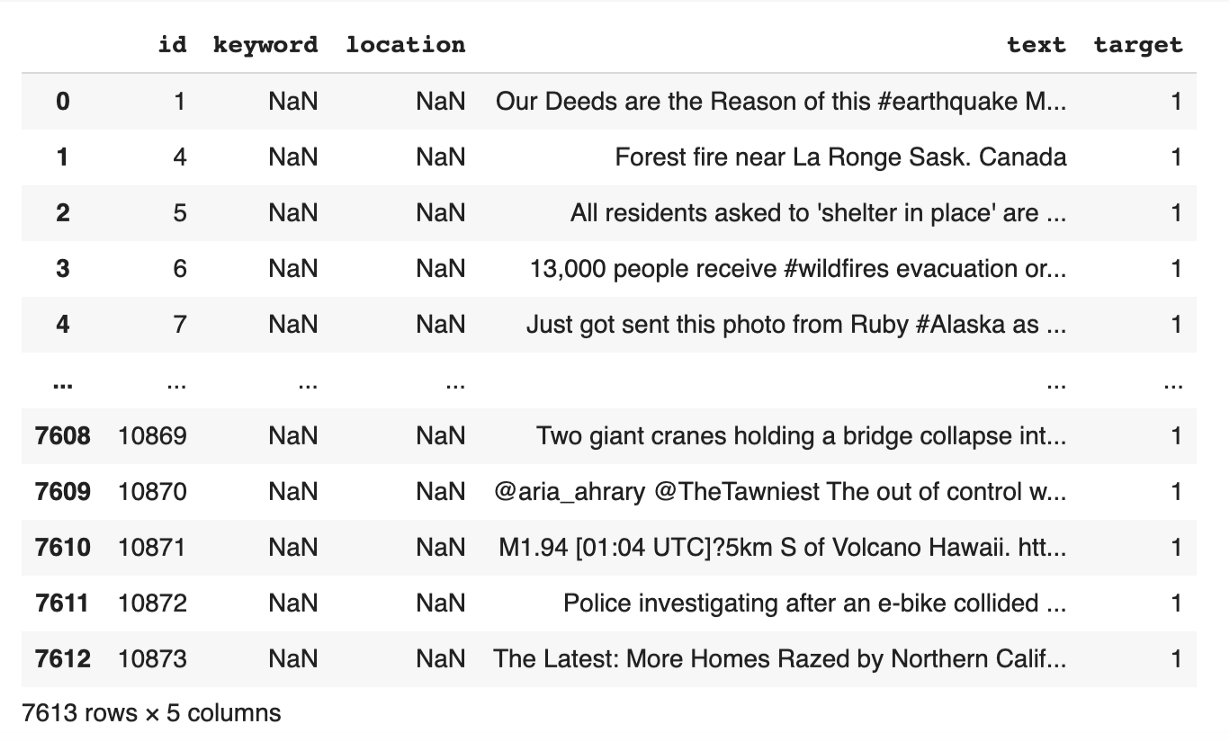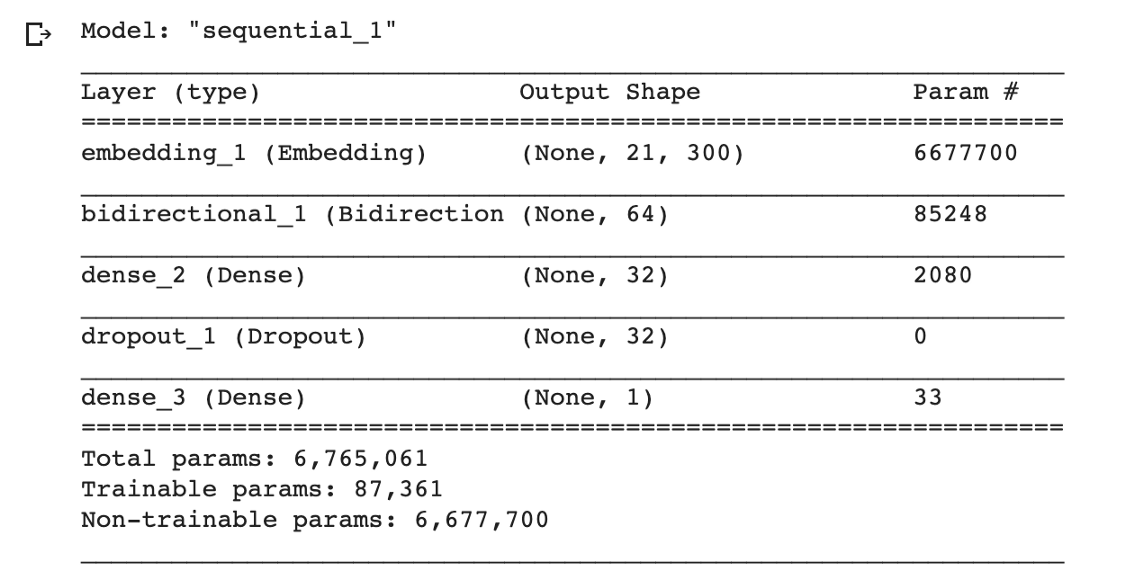作者|Emmanuella Anggi
编译|VK
来源|Towards Data Science

在这篇文章中,我将详细介绍如何使用fastText和GloVe作单词嵌入到LSTM模型上进行文本分类。
我在写关于自然语言生成的论文时对词嵌入产生了兴趣。词嵌入提高了模型的性能。在本文中,我想看看每种方法(有fastText和GloVe以及不使用)对预测的影响。
在我的Github代码中,我还将结果与CNN进行了比较。我在这里使用的数据集来自Kaggle,由tweets组成,标签是表明推特是否是灾难性推特(描述灾难的推特)。说实话,在第一次看到这个数据集时,我立刻想到了BERT,它的理解能力比我在本文中提出的更好(进一步阅读BERT)。
但无论如何,在本文中,我将重点介绍fastText和GloVe。
数据+预处理
数据包括7613条tweet(Text列)和label(Target列),不管他们是否在谈论真正的灾难。有3271行通知实际灾难,有4342行通知非实际灾难。如果你想了解更多关于数据的信息,可以在这里阅读。
链接:https://www.kaggle.com/c/nlp-getting-started

文本中真实灾难词的例子:
“ Forest fire near La Ronge Sask. Canada “
使用灾难词而不是关于灾难的例子:
“These boxes are ready to explode! Exploding Kittens finally arrived! gameofkittens #explodingkittens”
数据将被分成训练(6090行)和测试(1523行)集,然后进行预处理。我们将只使用文本列和目标列。
from sklearn.model_selection import train_test_split
data = pd.read_csv('train.csv', sep=',', header=0)
train_df, test_df = train_test_split(data, test_size=0.2, random_state=42, shuffle=True)
此处使用的预处理步骤:
-
小写
-
清除停用词
-
标记化
from sklearn.utils import shuffle
raw_docs_train = train_df['text'].tolist()
raw_docs_test = test_df['text'].tolist()
num_classes = len(label_names)
processed_docs_train = []
for doc in tqdm(raw_docs_train):
tokens = word_tokenize(doc)
filtered = [word for word in tokens if word not in stop_words]
processed_docs_train.append(" ".join(filtered))
processed_docs_test = []
for doc in tqdm(raw_docs_test):
tokens = word_tokenize(doc)
filtered = [word for word in tokens if word not in stop_words]
processed_docs_test.append(" ".join(filtered))
tokenizer = Tokenizer(num_words=MAX_NB_WORDS, lower=True, char_level=False)
tokenizer.fit_on_texts(processed_docs_train + processed_docs_test)
word_seq_train = tokenizer.texts_to_sequences(processed_docs_train)
word_seq_test = tokenizer.texts_to_sequences(processed_docs_test)
word_index = tokenizer.word_index
word_seq_train = sequence.pad_sequences(word_seq_train, maxlen=max_seq_len)
word_seq_test = sequence.pad_sequences(word_seq_test, maxlen=max_seq_len)
词嵌入
第1步:下载预训练模型
使用fastText和Glove的第一步是下载每个预训练过的模型。我使用google colab来防止我的笔记本电脑使用大内存,所以我用request library下载了它,然后直接在notebook上解压。
我使用了两个词嵌入中最大的预训练模型。fastText模型给出了200万个词向量,而GloVe给出了220万个单词向量。
fastText预训练模型下载
import requests, zipfile, io
zip_file_url = “https://dl.fbaipublicfiles.com/fasttext/vectors-english/wiki-news-300d-1M.vec.zip"
r = requests.get(zip_file_url)
z = zipfile.ZipFile(io.BytesIO(r.content))
z.extractall()
GloVe预训练模型下载
import requests, zipfile, io
zip_file_url = “http://nlp.stanford.edu/data/glove.840B.300d.zip"
r = requests.get(zip_file_url)
z = zipfile.ZipFile(io.BytesIO(r.content))
z.extractall()
第2步:下载预训练模型
FastText提供了加载词向量的格式,需要使用它来加载这两个模型。
embeddings_index = {}
f = codecs.open(‘crawl-300d-2M.vec’, encoding=’utf-8')
# Glove
# f = codecs.open(‘glove.840B.300d.txt’, encoding=’utf-8')
for line in tqdm(f):
values = line.rstrip().rsplit(‘ ‘)
word = values[0]
coefs = np.asarray(values[1:], dtype=’float32')
embeddings_index[word] = coefs
f.close()
第3步:嵌入矩阵
采用嵌入矩阵来确定训练数据中每个词的权重。
但是有一种可能性是,有些词不在向量中,比如打字错误、缩写或用户名。这些单词将存储在一个列表中,我们可以比较处理来自fastText和GloVe的词的性能
words_not_found = []
nb_words = min(MAX_NB_WORDS, len(word_index)+1)
embedding_matrix = np.zeros((nb_words, embed_dim))
for word, i in word_index.items():
if i >= nb_words:
continue
embedding_vector = embeddings_index.get(word)
if (embedding_vector is not None) and len(embedding_vector) > 0:
embedding_matrix[i] = embedding_vector
else:
words_not_found.append(word)
print('number of null word embeddings: %d' % np.sum(np.sum(embedding_matrix, axis=1) == 0))
fastText上的null word嵌入数为9175,GloVe 上的null word嵌入数为9186。
LSTM
你可以对超参数或架构进行微调,但我将使用非常简单的一个架构,它包含嵌入层、LSTM层、Dense层和Dropout层。
from keras.layers import BatchNormalization
import tensorflow as tf
model = tf.keras.Sequential()
model.add(Embedding(nb_words, embed_dim, input_length=max_seq_len, weights=[embedding_matrix],trainable=False))
model.add(Bidirectional(LSTM(32, return_sequences= True)))
model.add(Dense(32,activation=’relu’))
model.add(Dropout(0.3))
model.add(Dense(1,activation=’sigmoid’))
model.summary()

from keras.optimizers import RMSprop
from keras.callbacks import ModelCheckpoint
from tensorflow.keras.callbacks import EarlyStopping
model.compile(loss='binary_crossentropy', optimizer='adam', metrics=['accuracy'])
es_callback = EarlyStopping(monitor='val_loss', patience=3)
history = model.fit(word_seq_train, y_train, batch_size=256, epochs=30, validation_split=0.3, callbacks=[es_callback], shuffle=False)
结果
fastText的准确率为83%,而GloVe的准确率为81%。与没有词嵌入的模型(68%)的性能比较,可以看出词嵌入对性能有显著的影响。
fastText 嵌入的准确度

GloVe 嵌入的准确度

没有词嵌入的准确度

如果你想将代码其应用于其他数据集,可以在Github上看到完整的代码。
Github上完整代码:https://github.com/emmanuellaanggi/disaster_tweet_sentiment。
欢迎关注磐创AI博客站:
http://panchuang.net/
sklearn机器学习中文官方文档:
http://sklearn123.com/
欢迎关注磐创博客资源汇总站:
http://docs.panchuang.net/